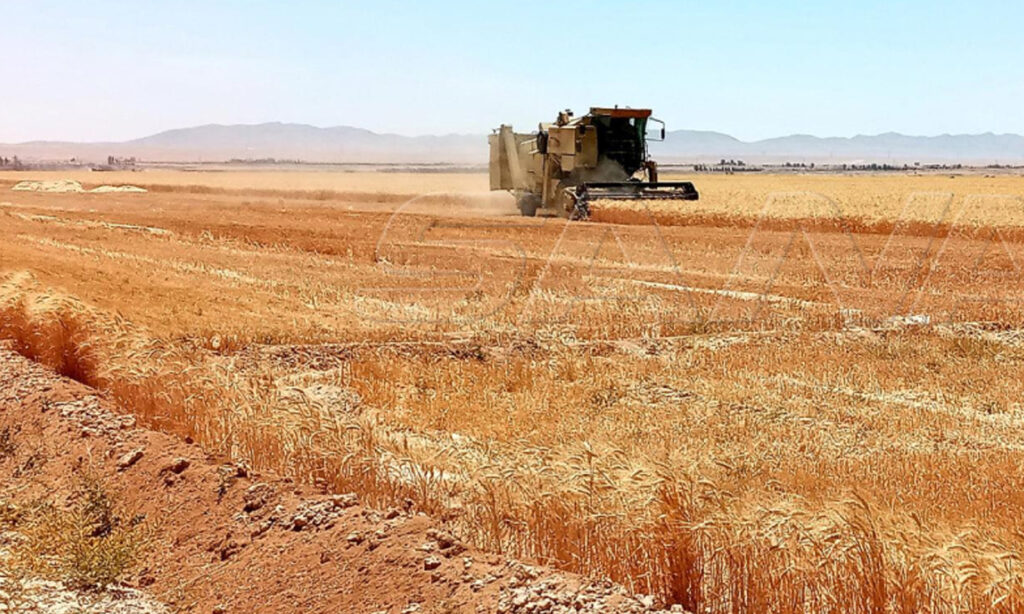Enab Baladi – Homs
On his motorbike, the 48-year-old Abu Mohammad strolls every month in the farms of the northern countryside of Homs city to buy hay for his livestock.
He stands near the combine that started harvesting a field in the farms of al-Rastan town.
“The hay season this year is very little since the spring rains did not fall sufficiently, and the ears of wheat never grew,” Abu Mohammad told Enab Baladi.
“Hay is the main food for livestock during the winter, and if we do not buy now, we will have to sell the flocks next winter,” he added.
The wheat harvest season has begun with the receding of the recent heat wave in central Syria.
The livestock breeders have also started their race to buy hay, whose price has risen, reaching 1000 Syrian pounds (about 25 US cents) per kilogram at the end of last season.
The high costs of harvesting, and the failure of the wheat season, raised the price of hay since the beginning of the season to 500 Syrian pounds per kilogram, in addition to packing and transportation fees.
Hike in hay prices
Livestock breeders depend entirely on hay to feed the herds of livestock due to the lack of pastures during the winter season, so hay is considered a major and parallel crop for the grain farmers of wheat, flat peas, and fennel.
Abu Mohammad, Enab Baladi withheld his full name for security reasons, owns a flock of sheep in the village of Izz al-Din, east of the city of al-Rastan.
“During the winter period, the grazing season ends, and we start feeding the livestock from the stores. We give the sheep one meal of fodder, the price of which has reached 4,500 Syrian pounds per kilo, and two meals of hay plus barley.”
Breeders seek to buy hay and store it in warehouses directly from the fields for fear of its high price and before the start of smuggling it to Lebanon, as happened last year.
“We try to buy what we can of hay during the harvest season—the price of hay doubles during the winter. Last winter, the price of a kilo reached more than a thousand pounds, if available, after it was smuggled by traders to Lebanon,” Abu Mohammad added.
Harvest costs increase prices
The cost of wheat harvest increased to 50,000 Syrian pounds per dunum (about 1000 m²) after the increase in the price of diesel, which reached 4,000 Syrian pounds per liter in the black market, while peasant associations distributed four liters of subsidized diesel for every registered dunum of wheat.
Luqman, 39, a combine driver from Talbiseh town, told Enab Baladi, “The harvester needs eight liters of diesel to harvest every dunum, the price of which is more than 30,000 pounds. The government did not commit to providing the harvesters with agricultural diesel but distributed four liters to farmers for every dunum.”
Luqman, who declined to give his full name for security reasons, added that 50,000 pounds is the minimum wage. At the same time, the price of the harvester exceeds 100 million pounds, and its maintenance costs are very high.
The exchange rate of the US dollar against the Syrian pound during the past week reached 4000 pounds, according to the Syrian Pound Today website.
The high costs of combines have reflected on the prices of hay, as wheat is an important strategic crop, and the state does not allow traders to deal with it and monopolizes its purchase, marketing, and price setting, which makes farmers unable to raise its price, forcing them to raise the prices of hay to cover the costs that can be covered.
New types of livestock fodder
Livestock farmers depended on wheat, barley, and flat peas hay to feed their flocks, but the high prices opened the door for the hay of the rest of the crops to enter the herds’ fodder.
In 2022, some livestock breeders were forced to buy new types of hay that they did not rely on in the past, according to Luqman, such as coriander and fennel hay, which farmers used to get rid of by burning, or they used to take it for free to cover the barns with it.
The price of a kilogram of flat peas hay reached 1000 Syrian pounds, and the price of the same quantity of barley straw reached 600 pounds, in addition to the costs of packaging and transportation, while the price of coriander and fennel hay ranged between 50 and 100 Syrian pounds per kilogram.

